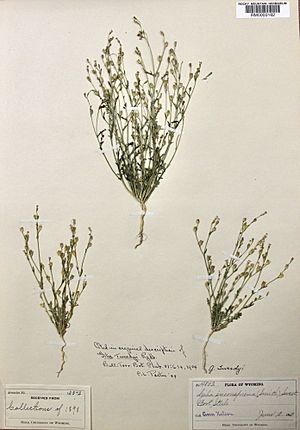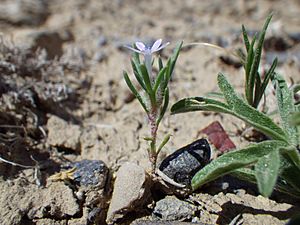Tweedy's gilia facts for kids
Quick facts for kids Tweedy's gilia |
|
|---|---|
 |
|
| Gilia tweedyi collected in 1898, Fort Steele, Wyoming, USA | |
| Scientific classification | |
| Genus: |
Gilia
|
| Species: |
tweedyi
|
Gilia tweedyi, also known as Tweedy's gilia, is a small plant that lives for only one year. It belongs to the phlox family. You can find it growing naturally in the northwestern parts of the United States.
Contents
Naming This Plant
A scientist named Per Axel Rydberg first described and named Gilia tweedyi in 1905. He named it after Frank Tweedy, who was one of the first people to collect this plant. Rydberg used a plant sample collected by Tweedy in 1901 as the main example for his description. This special sample is kept at the New York Botanical Garden.
At first, scientists thought Gilia tweedyi was very similar to other plants. Because of these similarities, its name was changed a few times. For a while, it was considered a type of Gilia minutiflora or Gilia inconspicua. However, scientists later decided that Gilia tweedyi is its own unique species. So, Gilia tweedyi is the correct name used today.
What Does Tweedy's Gilia Look Like?
Tweedy's gilia is an annual plant, meaning it grows and dies within one year. It can be anywhere from 5 cm (2.0 in) to 40 cm (16 in) tall. Its stems often have branches. How tall it grows and how many branches it has can depend on where it lives.
The stems and leaves of this plant have special cotton-like or cobweb-like hairs. They also feel a bit sticky, especially near the top of the plant. The leaves at the bottom of the plant are about 2–5 cm (0.79–1.97 in) long. They have deep cuts or lobes with sharp tips. The leaves higher up on the stem are smaller but also have these sharp tips.
The flowers grow in an open cluster. Each flower has petals that are joined together, forming a funnel shape. They are blue with a yellow center. The tube part of the flower can be up to 5 mm long. When the plant is mature, its seed capsules are about 4–5 mm (0.16–0.20 in) long.
Where Does Tweedy's Gilia Grow?
Tweedy's gilia is found in the northwestern United States. Its native range stretches from Oregon through central Idaho and east to Montana. It also grows south into northeast Nevada, Wyoming, and northwest Colorado.
This plant likes to grow in dry places. You can find it in juniper woodlands, areas with sagebrush, and other desert shrublands. It also grows in dry grasslands and on bare, rocky sites. It can live at different heights, from 500 m (1,600 ft) up to 2,500 m (8,200 ft) above sea level.
Protecting Tweedy's Gilia
Globally, Tweedy's gilia is considered "apparently secure." This means that there are enough of these plants around the world, and they are not in danger of disappearing. However, in the states of Montana and Wyoming, people are paying closer attention to this plant. It is considered a plant of state conservation concern in those areas. This means they want to make sure its populations stay healthy in those specific states.
How Was This Plant Discovered?
As mentioned, Gilia tweedyi was named by Per Axel Rydberg to honor botanist Frank Tweedy. Frank Tweedy collected some of the very first samples of this plant. One of his samples, number 4422, was used by Rydberg to officially describe the plant.
At the time, Tweedy worked as a mapmaker for the United States Geological Survey. He collected the main sample in 1901 from a river bottom near Encampment, Wyoming. It was found at an elevation of about 7200 feet. Other early samples were collected by Aven Nelson, a botany professor, in southern Wyoming in 1898. Frank Tweedy also collected more samples in the Bighorn Mountains, Wyoming, in 1900. These additional samples helped scientists learn more about the plant.


